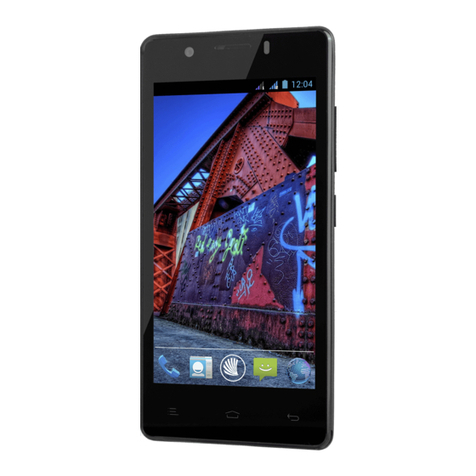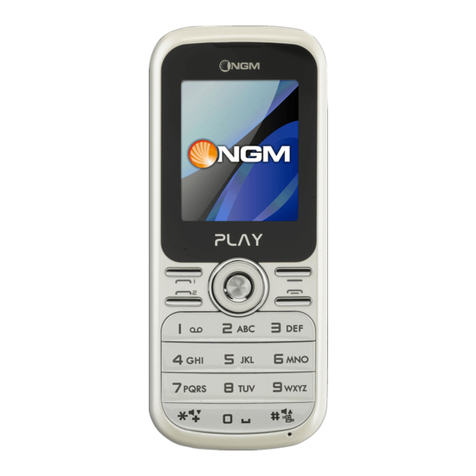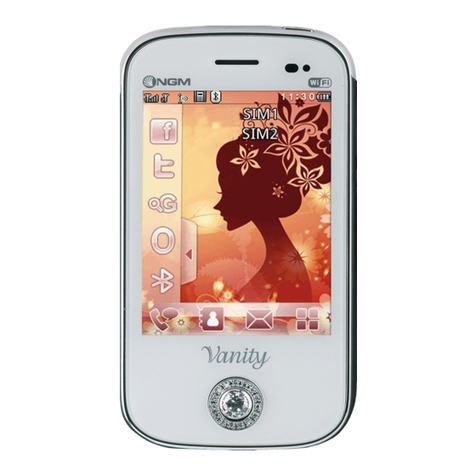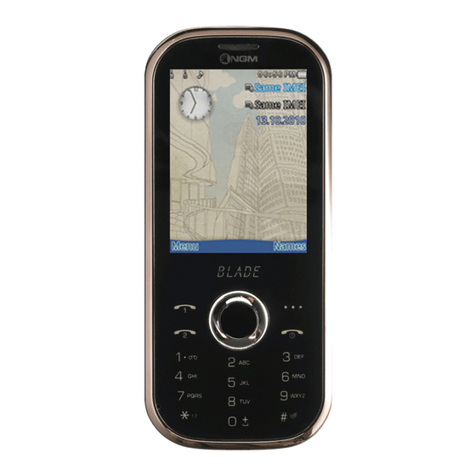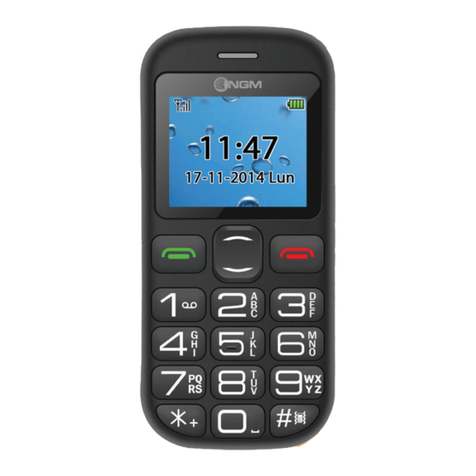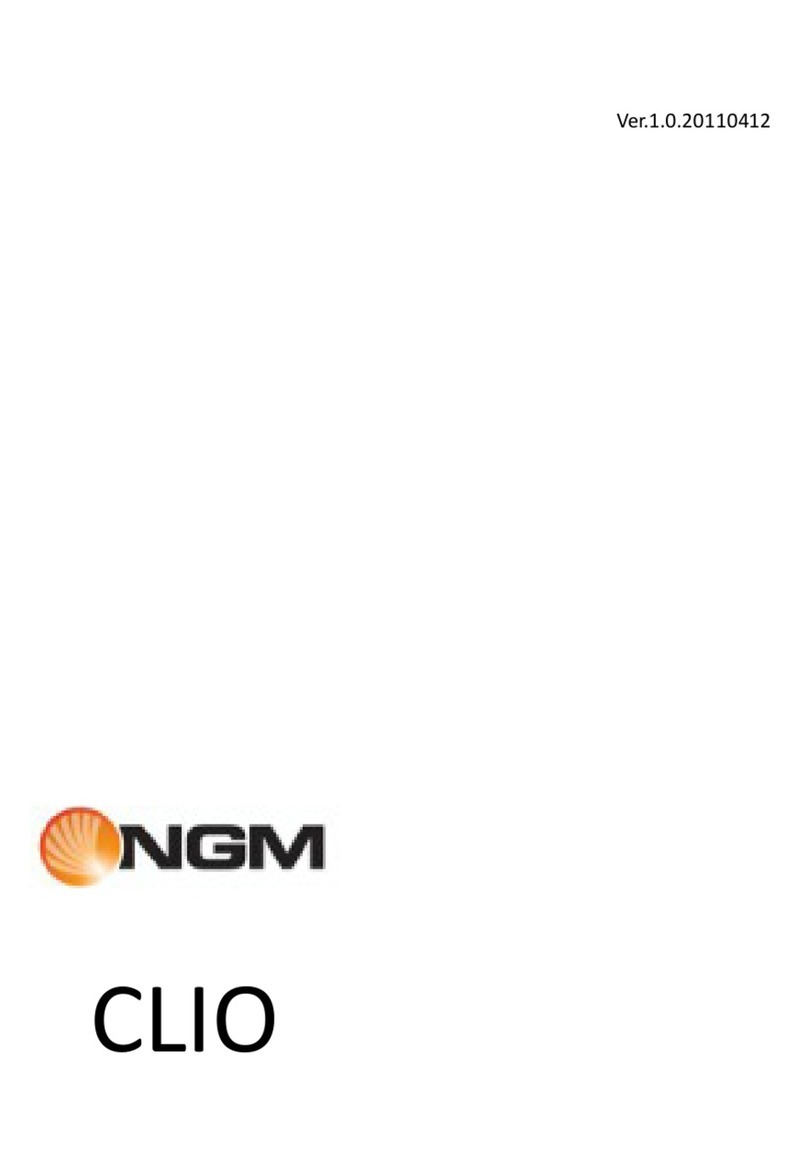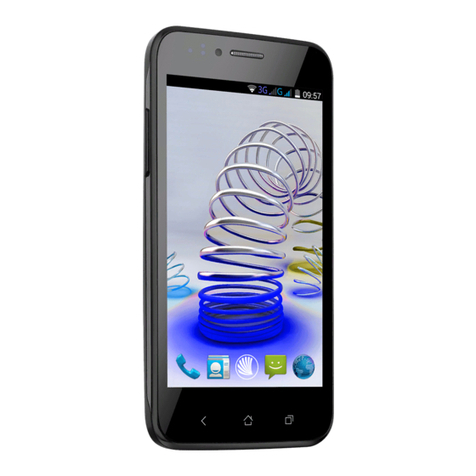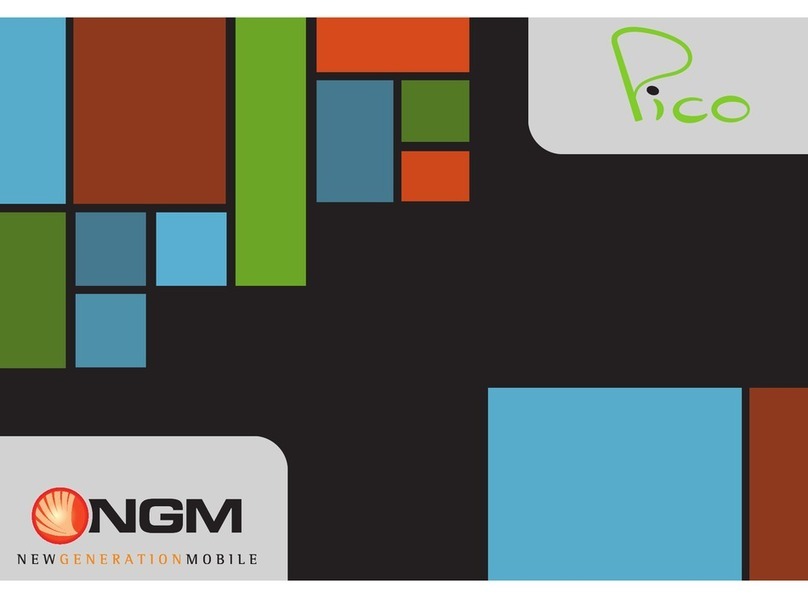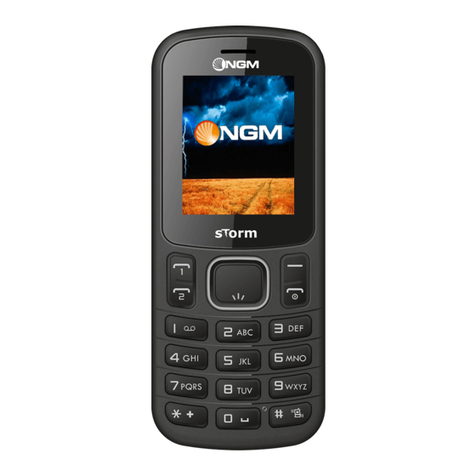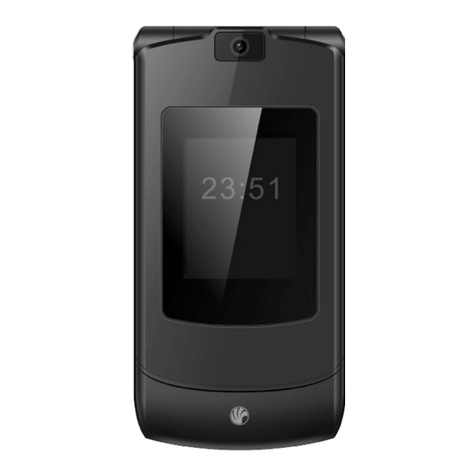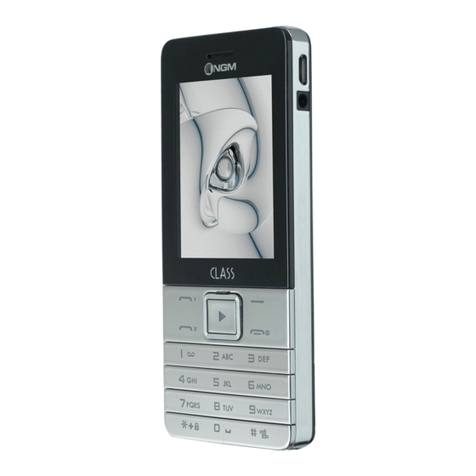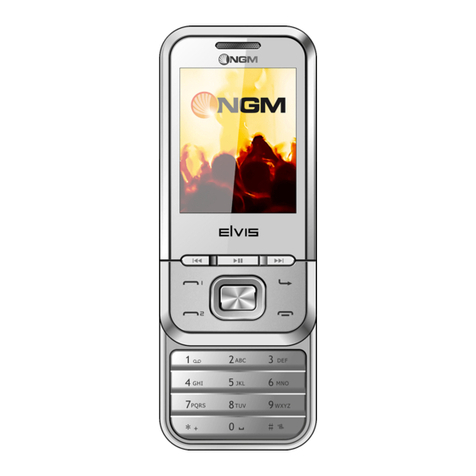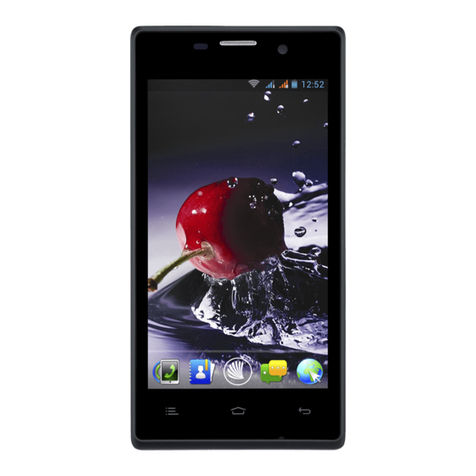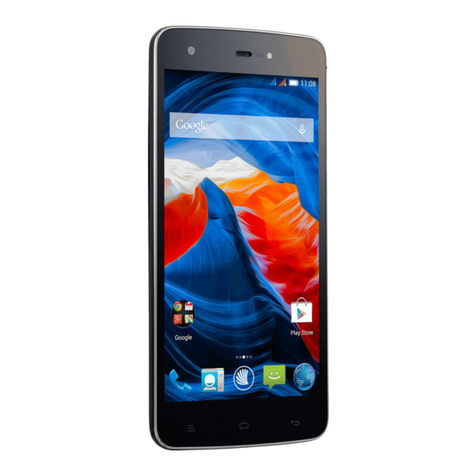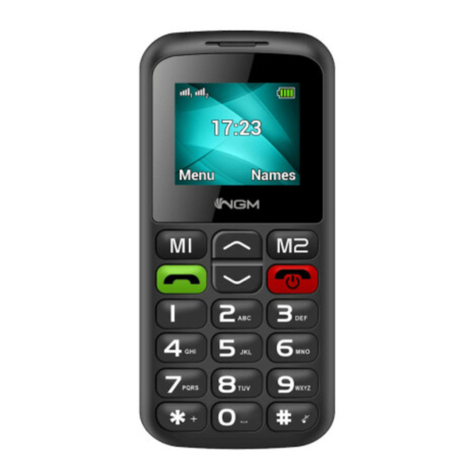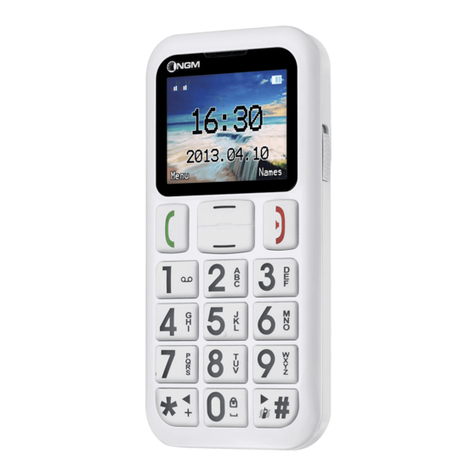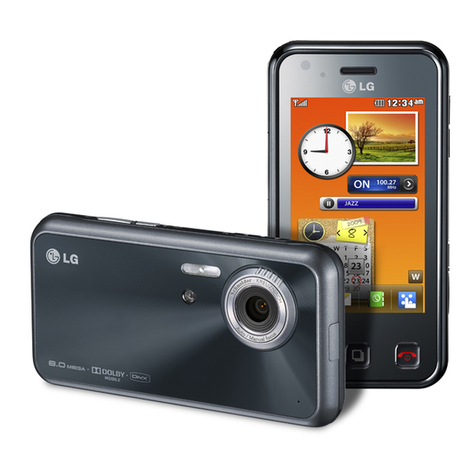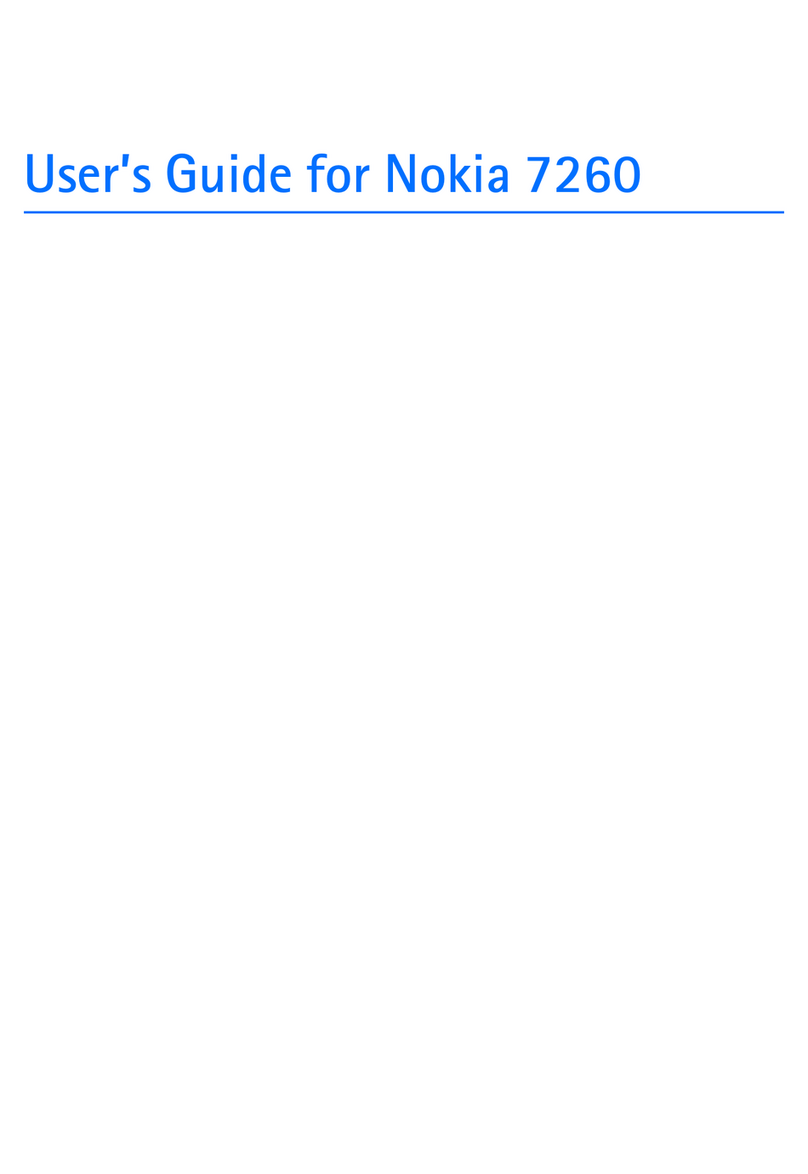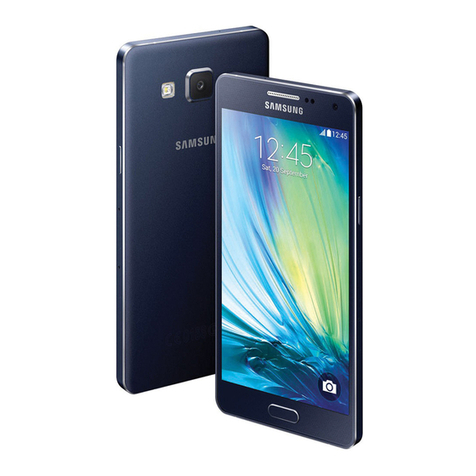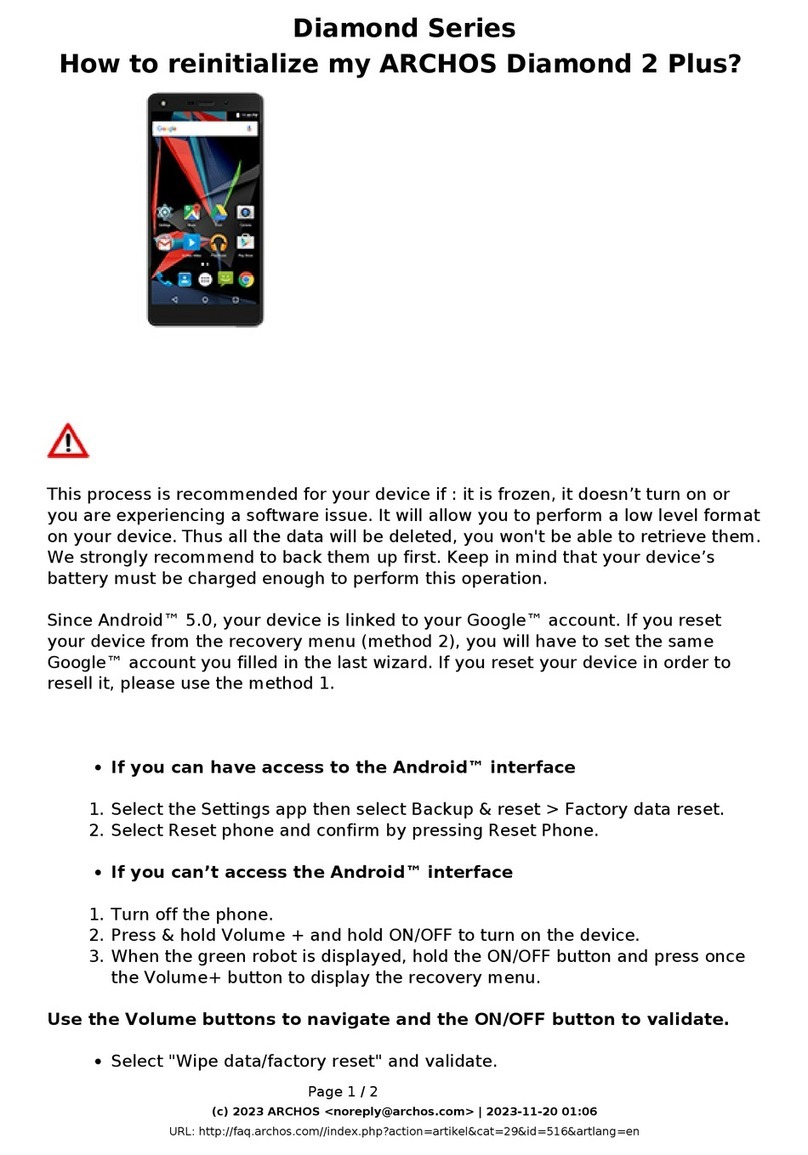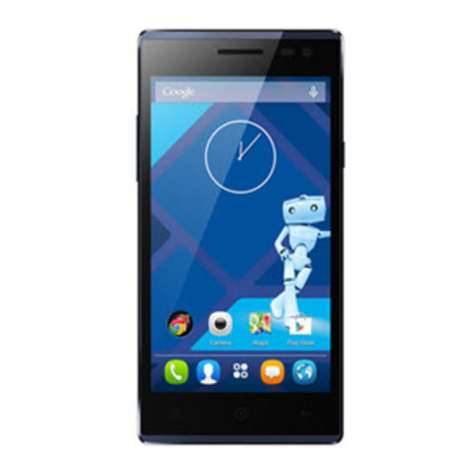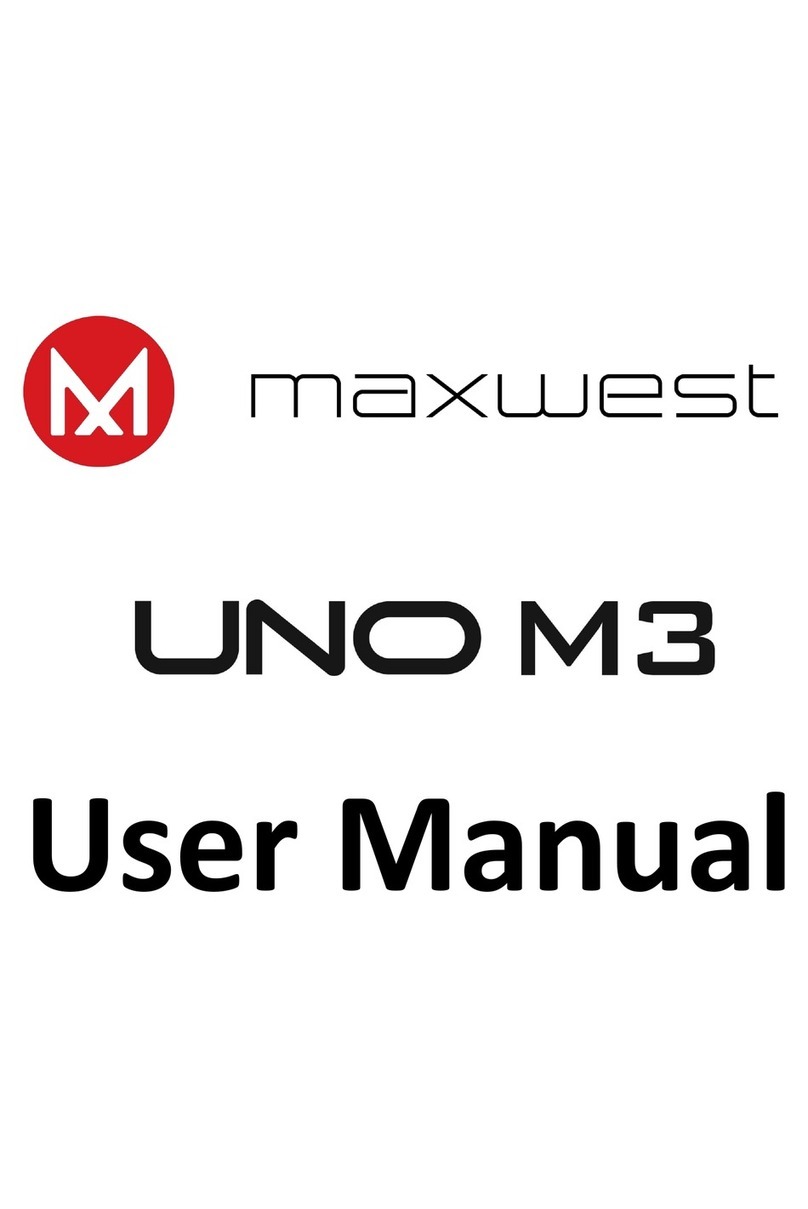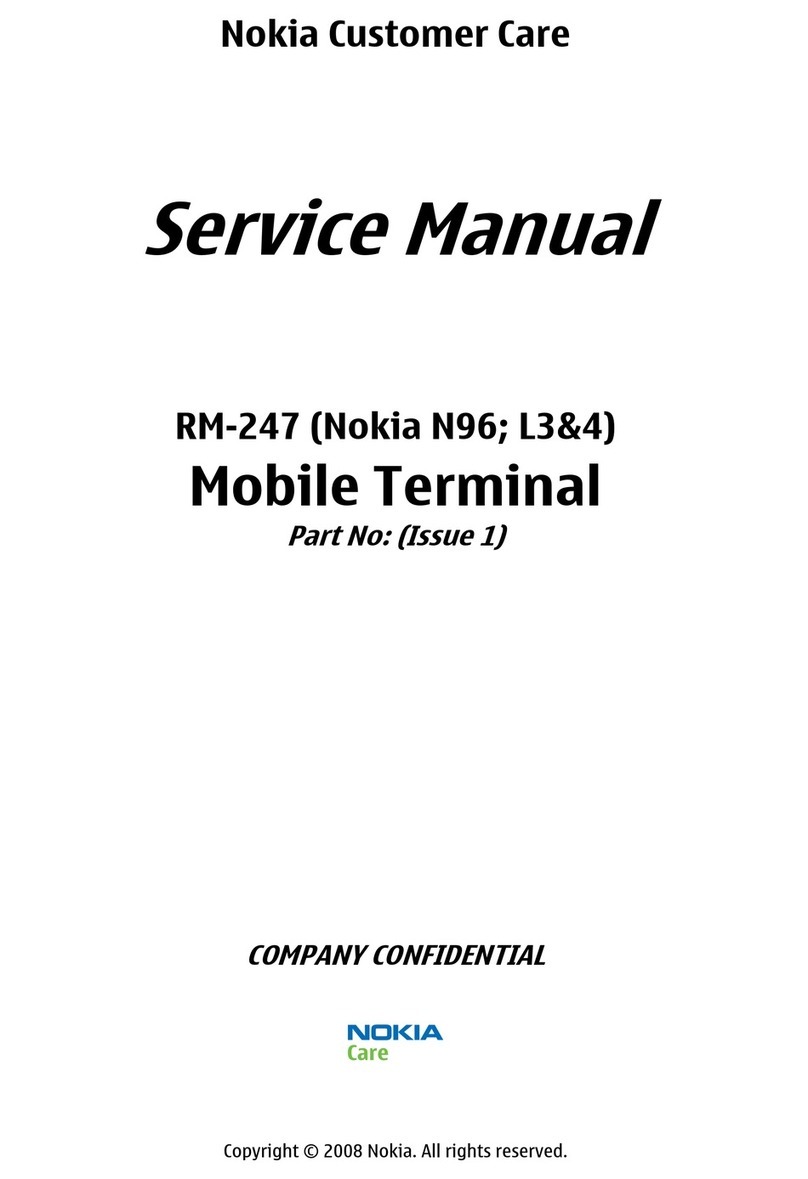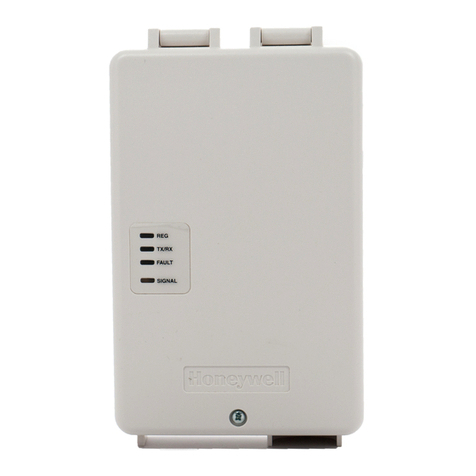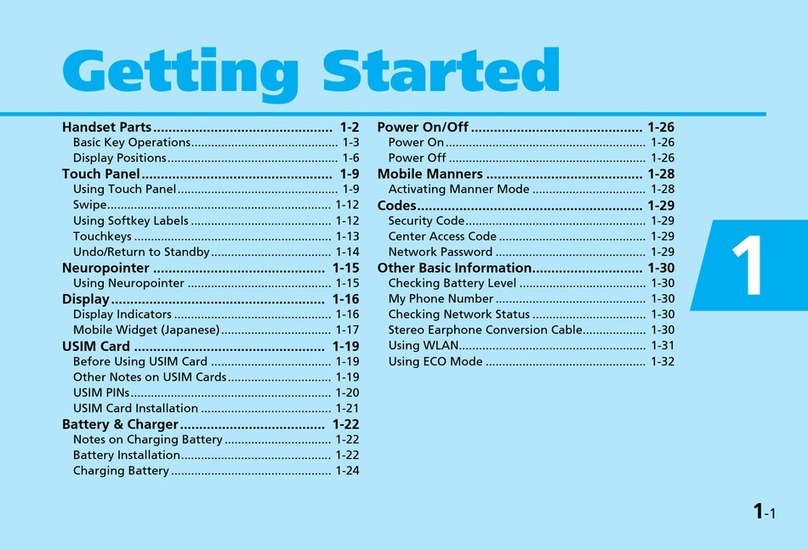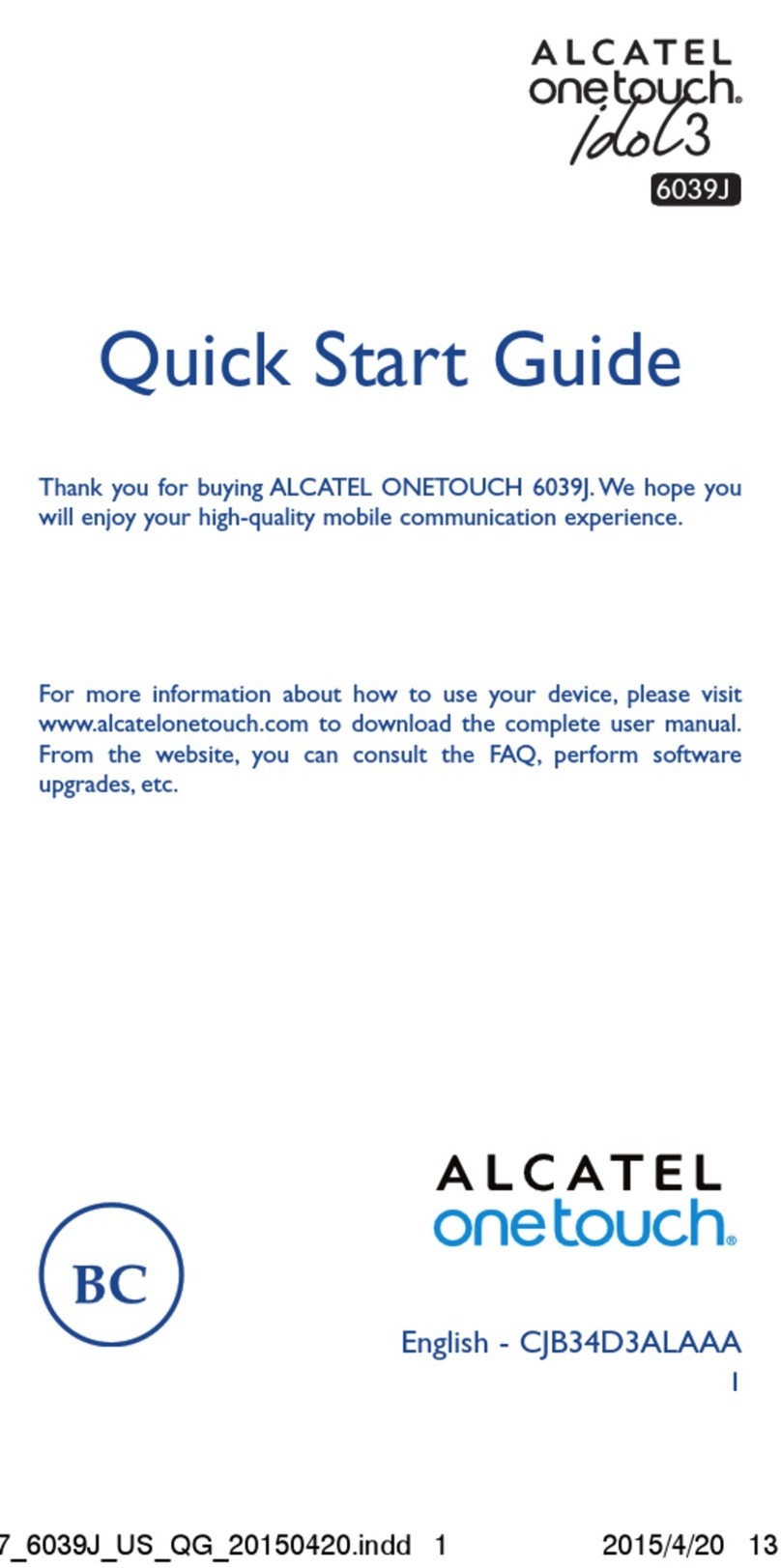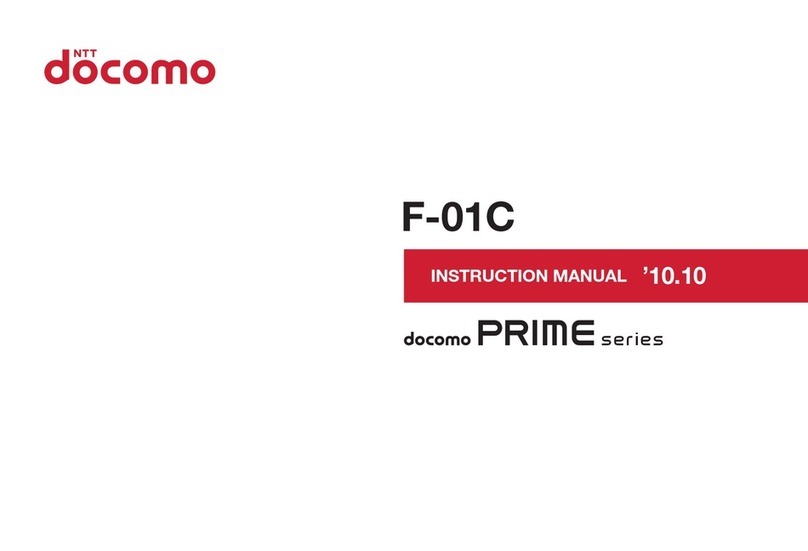NGM SWAT User manual

Quick Guide ENG

Setting up
Installing the SIM card
The SIM card contains information such as your personal phone
number, PIN code, service numbers, contacts and other
important details.
The SIM cards have to be inserted into the slots placed in the
back side of the phone. In order to access the slots, the phone
must be powered off, the cover and the battery removed.
SIM cards must be inserted with the golden contacts facing
downwards.
Installing the Memory card
The MicroSD card must be inserted, as for the SIM cards, into
the back side of the phone, after powering it off and removing
the battery. A dedicated slot for the memory card is placed
right in front of the SIM cards. Unlock the slot clap by pushing it
towards “Open”, then open it and fit the memory card into
position, with the golden contacts facing downwards. Then
close and lock the clap by pushing it towards “Lock”.
Micro
SD
SIM 1
SIM 2

Inserting the battery
Your device is provided with a lithium-ion battery and is
designed to be used exclusively with original NGM batteries and
chargers. The battery must be inserted into the backside of the
phone. Align the battery contacts with the phone contacts
inside the battery tray, and let it slide down into position. Once
the battery is inserted, close the rear cover by gently pushing it
back into position.
Charging the battery
Please charge the battery completely before starting to use the
device. First, insert the charger into the wall socket, then
connect the USB cable with the phone; use the provided USB
cable to connect one end to the provided wall socket adaptor
and the other end to the USB connector placed on the side of
the phone after removing it’s protective cover.
Warning: Never connect the phone to a computer powering
on/off to avoid voltage jumps.
While the battery is charging, an animated icon on the screen
will show the charging progress. Once the progress bar is full,
the phone can be disconnected from the charger. Replace the
socket cover thoroughly.
Note: Use only the provided USB cable for recharging the device.
Always charge the battery indoors in a dry and safe
environment.
A slight warming up during the charging process is normal.
The battery will not reach its full capacity until cycled several
times.

Profile
Speaker
Camera
Micro-USB
Socket cover
Receiver
Display
SIM1 Call key
Standard keyboard
SIM2 Call key
Directional Keys
OK Key
End Key and On/Off
Back Key

Stand-by screen
The main menu
Multimedia
Organizer
Phonebook
NGM
Spezialfunktione
n
Call center
Settings
Connectivity
Messaging
Menu Header
Apps & Games
Battery
Notifications
SIM1/SIM2 signal strenght
Phonebook
Main Menu
Call logs
Active Profile

A thought for environment
NGM cares about the effects that the used materials can have
on environment throughout their life cycle and therefore
promotes their responsible use replacing them –when possible
–with eco-compatible materials that can be recycled.
In this specific case, the external cover of SWAT is made out of
recycled plastic material.
Making a phonecall
Voice call
1. From the main screen, digit the desired phone number
using the telephone keypad. While inserting the numbers,
the lower side of the display will gradually show the saved
contacts containing the numbers that are digited. If the
desired contact appears, just select it with the directional
keys and press OK to select it.
2. Press either the SIM1 or SIM2 call key to call the number.
3. To end the call, press the END key.
Recall a number from the call logs
1. From main screen press the SIM1 or SIM2 call keys key to
access the call logs list of both SIM cards separately.
2. Select a contact or number from the list, then press
Options > call > from SIM1 or SIM2 to make the call.
Managing contacts
Adding a new contact
1. From the main screen, press the BACK button to open the
Phonebook.
1. Click Add new contact and Select.
2. Select the location where you want to save the new
contact (Phone or SIM1/SIM2).
3. Confirm saving.

Add a new contact from the call logs
1. From the main screen, press the OK key to open the main
menu.
2. Choose Call center > Call history > SIM1/SIM2 call history
and choose the contact number you want to save (scrolling
the list including the Missed calls, Dialed calls and
Received calls.
3. Click Options, then Save to Phonebook > Add contact >
SIM1/2 or Phone, insert the name and confirm saving.
Setting ringtones
Select a ringtone
1. From the main screen, select Menu.
2. Select Settings > User Profiles > General > Options >
Customize > Configure Tone > Incoming Call (SIM1 or
SIM2).
3. Select the desired ringtone from the list, then click OK.
4. It is possible to add a customized ringtone. From the
Incoming call menu (SIM1 or SIM2), select an empty slot at
the bottom of the list, then click Replace and choose an
audio file from the folders in the phone or memory card
memory.
Note: It is possible to use files in .mid, .wav or .mp3 format. The
same procedure is of course applicable also to other profiles
contained in User Profiles.
Keypad lock and shortcuts
Locking the keys
To lock the keys, press the OK key from the main screen for a
few seconds. To unlock, press the SIM1 call key and then “*”.
To set the automatic keylock, choose Settings > Security
settings > Auto keypad lock and choose the desired timing
between the available ones.
Fast activation of the vibration profile
1. From the main screen, press and hold the #key to quickly
turn on the Vibration Profile.
2. By pressing and holding the same key again, the previous
user profile will be restored.
Rapid access to the favorite functions
In Settings > Phone settings > shortcuts you can assign
shortcuts to the Up, Down, Left and Right keys.
These shortcuts are available from the main screen.

Configuration of both SIM cards
Disabling/enabling Dual SIM
1. From the main screen, select menu.
2. Select Settings > Dual SIM settings.
3. Select Only SIM1/2 open, Dual SIM open or Flight mode
and confirm.
Text input
Text input using T9
T9 is a predictive text entry method; when writing SMS
messages, this method suggests the statistically most used
words. T9 mode is set by default, and it is possible to customize
the system integrated dictionary by adding new words it.
In order to change the text input method, press “#” in the text
input screen.
Send and receive messages
Sending SMS and MMS
1. From the main menu, select Messages > Write Message
for quick access to the text entry screen.
2. Enter text using the standard keyboard.
3. If you wish to send an MMS, choose Options > Switch to
MMS.
4. Once the message is ready, press OK to choose whether
to insert the recipient’s number directly or retrieve it
from the phone book.
5. Select which SIM to use to send out your SMS.
NGM programmed sending of SMS messages
This option allows to send a delayed SMS, on the wished day
and time point. Select NGM > SMS Delayed sending.
Bluetooth
Connecting to a Bluetooth device
1. Turn on the Bluetooth device to which you want to
connect. Where necessary, refer to the documentation of
the device.
2. From the Menu screen, choose Connectivity > Bluetooth.
Activate the Bluetooth state selecting Power on.
3. Select My device > Search new device to start searching
for Bluetooth devices.
4. Select the device name to associate with, and then
choose Associate. The phone will try to connect to the
device, eventually asking for the pairing code.
5. I you wish to pair ad audio device, select Bluetooth >
Search audio device and pair/connect the device.

NGM Special functions
Black List
This option allows you to set up a list of phone numbers
(contacts) that you want to block. If the function is activated,
the black-listed caller will hear the tone of “congested line”
(network error) and you will eventually receive an SMS from
your operator notifying you of the phone number of the caller.
In NGM > Calls & SMS firewall >SIM1/SIM2 > Calls/SMS > BL
you enter the Blacklist numbers. Activate the Blacklist through
NGM > Calls & SMS firewall >SIM1/SIM2 > Calls/SMS >
Settings > Blacklist state.
White List
This feature allows you to set up a list of callers that are the
only ones to be allowed. When the function is activated, callers
not included in the Whitelist will hear the tone of “congested
line” (network error) and you will eventually receive an SMS
from your operator notifying you of the phone number of the
caller. In NGM > Calls & SMS firewall >SIM1/SIM2 > Calls/SMS
> WL you enter the Whitelist numbers. Activate the Whitelist
through NGM > Calls & SMS firewall >SIM1/SIM2 > Calls/SMS
> Settings > Whitelist state.
Blocking anonymous numbers
When activated, incoming calls from anonymous users (hidden
ID) will automatically be rejected. Therefore, those callers will
hear the tone of “congested line”.
Get access to the function through NGM > Calls & SMS firewall
>SIM1/SIM2 > Calls/SMS > Settings > Block anonimous.
Blocking unknown numbers
When activated, incoming calls from phone numbers not
previously stored in the phonebook (SIM contacts included) will
automatically be rejected. Therefore, those callers will hear the
tone of “congested line”. Get access to the function through
NGM > Calls & SMS firewall >SIM1/SIM2 > Calls/SMS >
Settings > Block not in phonebook.
Note: All firewalls can be quickly inactivated by selecting NGM >
Calls & SMS firewall >SIM1/SIM2 > Calls/SMS > Settings >
Firewall close.
Private firewall
The private Firewall allows you to password-protect the access
to the archives of messages, contacts, and call logs (you can
select one, two or all three of them).
Get access to the function through Settings> Security Settings >
Privacy Firewall. Initially, the password is 1122. This is the
phone password that can freely be modified in Settings>
Security Settings > Change password.

Phone control
The phone control is a tool that ensures a higher security of the
phone for the user. It has three applications: SIM-binding,
Remote control and Trusted numbers. Access these
applications through NGM > Phone control.
Please refer to the SWAT User Manual for an exhaustive
description of these functions.
Answering machine
The telephone answering machine is a device designed to
record voice messages directly on the phone’s memory or
memory card without having to connect to the operator’s
server to listen to the recordings, thus avoiding relative charges.
Moreover, you can customize your answering machine greeting
message by recording it directly on the phone.
The answering machine will turn on after a preset number of
rings or can be manually operated as an answer option. Get
access to the function through NGM > Answer machine.
Background sounds
Background sounds can help recreating realistic environmental
sounds during a call (e.g. “Motorcycle”, “Sidewalk”,
“Restaurant” and other, user-customized ones). This option can
be set as default or can be set in time when answering a phone
call. Access through NGM > Background sounds.
Private Firewall
This function allows you to password-protect the access to the
archives of the Messaging, the Phonebook, Call history and the
File manager (One, some or all of them). Access to the private
firewall through Settings > Security settings > Privacy firewall.
Coffer
The coffer is a hidden area, accessible only by entering a special
Coffer lock from the main screen. For the first access, insert the
*0000# code from the main screen.
In the coffer, you can manage private contacts and messages.
Coffer Contacts are saved with their real name and number and
false name and numbers. Whenever a Coffer Contact calls, only
the false name and numbers will be visualized on the phone
display. Messages incoming from Coffer Contacts are received
discreetly and are only accessible entering the Coffer area. The
Coffer call logs display the received, made, missed calls with
Coffer Contacts.
The Coffer cannot be accessed by anyone not knowing the
Coffer Lock; any attempt entering the Coffer with the default
“0000” Code will lead the user into a false, completely empty
Coffer area.
Note: The”false Coffer”is not functional.

Certifications
Declaration of conformity (R&TTE)
We, NGM Italia
declare under our sole responsibility that the product identified
as
GSM Mobile Phone : SWAT
conforms to the following standards and specifications:
Health EN 50360, EN 62209-1
Safety EN 60950-1+A11
EMC EN 301 489-1/-7/-17
Radio EN 301 511
EN 300 328
We declare that [all the series of fundamental radio test have
been conducted and that] the aforesaid product meets all the
essential requirements of the Directive 1999/5/EC.
The conformity assessment procedure referred to in Article 10
and detailed in Annex IV of Directive 1999/5/EC has been
followed with the involvement of the following notified bodies:
Bay Area Compliance Laboratories Corp.
1274 Anvilwood Ave., Sunnyvale, CA 94089, USA
Website: www.baclcorp.com
All technical documents conserved at NGM Italia S.r.l.
Available on request.
(UE Authorized Representative)
NGM Italia S.r.l.
Via L. Da Vinci, 7 –Ponticelli
56020 Santa Maria a Monte (Pi)
S.A.R. (Specific Absorption Rate)
Informations on SAR certifications
Cell phones are radio transceivers. They have been projected
not to exceed the radio wave exposition limits recommended
by international guidelines. These guidelines have been
determined by the independent scientific organization ICNRP
and include security limits to ensure protection to all persons,
independently from their age and health conditions.
This phone meets European Union (EU) requirements
concerning exposure to radio waves coming from
telecommunication and radio devices. The exposure standard
for mobile phones employs a unit of measurement known as
SAR (Specific Absorption Rate). The SAR limit recommended by
the EU Council is 2.0 W/kg averaged over ten grams of body
tissue.
The highest SAR value for this model phone when tested for use
at the ear was 0,908 watt /kg 1 2. Although the SAR is
determined at the highest certified power level, the actual SAR
of the phone while operating can be well below the maximum
1313

value. This is because the phone is designed to operate at
multiple power levels so as to use only the power required to
reach the network. In general, the closer you are to a base
station, the lower the power output of the phone. The
Declaration of Conformity here above proves that the
designated product is in compliance with the essential
requirements and other relevant provisions of the R&TTE -
Directive (European Radio & Terminal Telecommunications
Equipment)1999/5/EC
1. These controls have been made according to international
guidelines on controls.
2. For the use next to the body, this telephone model has
been controlled and is conform to the directives for the
exposition to RF, also when used with accessories not
containing metallic parts or which position the mobile
phone at least at 1,5cm distance from the body.
Warnings
WHO (World Health Organization) confirms that the actual
scientific information does not indicate the necessity to adapt
particular precautions for the use of cell phones.
Nevertheless, for all those users not comforted by these data,
NGM advises to limit their own and their children’s exposure,
for instance by reducing the calling time, or by using earpieces
or hands-free devices to keep the mobile phone distant from
the body and the head.
For more information on the argument, NGM invites to consult
the WHO document (Fact sheet N°193, June 2011) entitled
Electromagnetic fields and public health: mobile phones at the
following web address:
http://www.who.int/mediacentre/factsheets/fs193/en/index.html
NGM advises to use mobile devices of any brand or model with
moderation and to keep them at a minimum distance of 1,5cm
from the body or to use earpieces or other hands-free devices.
Other manuals for SWAT
1
Table of contents
Other NGM Cell Phone manuals
